A pilot randomised controlled trial evaluating mini and conventional implant retained dentures on the function and quality of life of patients with an edentulous mandible
- PMID: 28202072
- PMCID: PMC5310054
- DOI: 10.1186/s12903-017-0333-1
A pilot randomised controlled trial evaluating mini and conventional implant retained dentures on the function and quality of life of patients with an edentulous mandible
Abstract
Background: Total tooth loss (edentulism) can be a debilitating condition, impacting on ability to chew, speak and interact with others. The most common treatment is with complete removable dentures, which may be successful, but in the lower jaw, bone resorption that worsens over time makes denture-wearing difficult. Two dental implants in the mandible to retain the lower denture has been advocated as the gold standard of treatment, but has not been universally provided due largely to financial constraints and also patient fear. Mini implants (MI) are cheaper and less invasive than conventional implants (CI), but may not have equivalent longevity. Therefore, it is unknown whether they represent a cost-effective treatment modality over time. The aim of this pilot randomised controlled trial was to assess the feasibility of carrying out a trial on this cohort of patients, and to inform the study design of a large multicentre trial.
Methods: Forty-six patients were randomly allocated to receive either two mini implants or two conventional implants in the mandible to retain their lower dentures. Quality of life (QoL) questionnaires, pain and anxiety scores, and an objective "gummy jelly" chewing test were carried out at multiple timepoints, along with detailed health economics information. Implants were placed one-stage, and an early loading protocol was utilised. Patients were reviewed 8 weeks post-placement, and finally at 6 months. Implant failure, recruitment and retention rates were recorded and analysed.
Results: The pilot study demonstrated that it is possible to recruit, randomise and retain edentulous (mainly elderly) patients for an implant trial. We recruited to target and retention rates were acceptable. The large number of questionnaires was onerous for participants to complete, but the distribution of scores and feedback from participants helped inform the choice of primary and secondary outcomes in a full trial. The chewing test was time-consuming and inconsistent. Implant failure rate was low (1/46). The data on indirect costs gathered at every visit was viewed as repetitive and unnecessary, as there was little or no change between visits.
Conclusions: The pilot study has shown that acceptable recruitment and retention rates are achievable in this population of patients for this intervention. The results provide valuable information for selection of outcome variables and sample size calculations for future trials.
Trial registration: (ISRCTN): 87342238 Trial registration date: 05/07/2013.
Keywords: Complete overdenture; Dental implant; Edentulous; Masticatory efficiency; Mini implant; Quality of life; Randomised controlled trial.
Figures
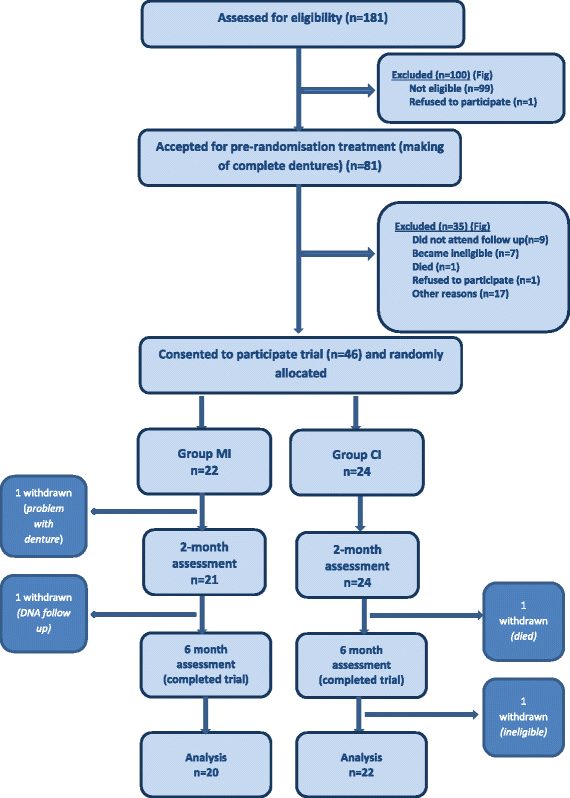
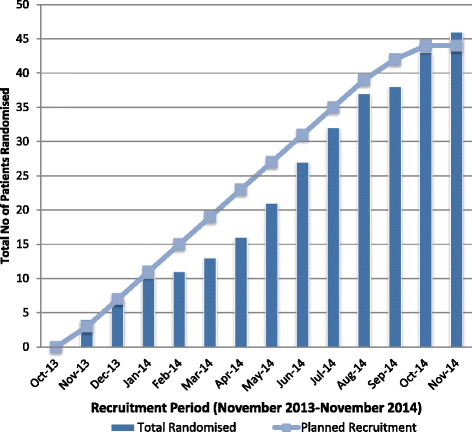
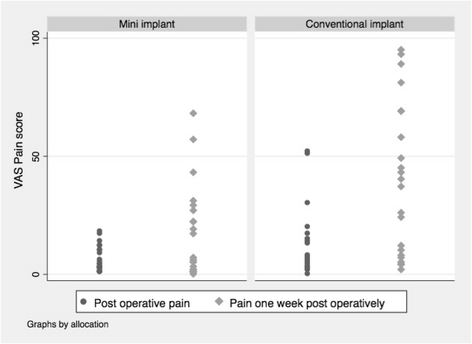
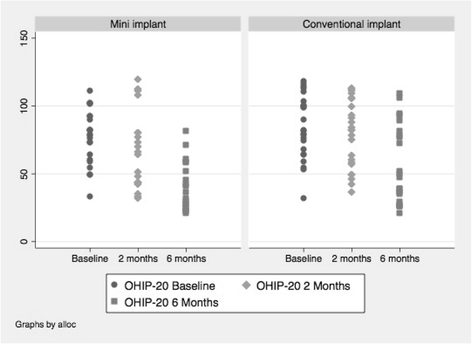
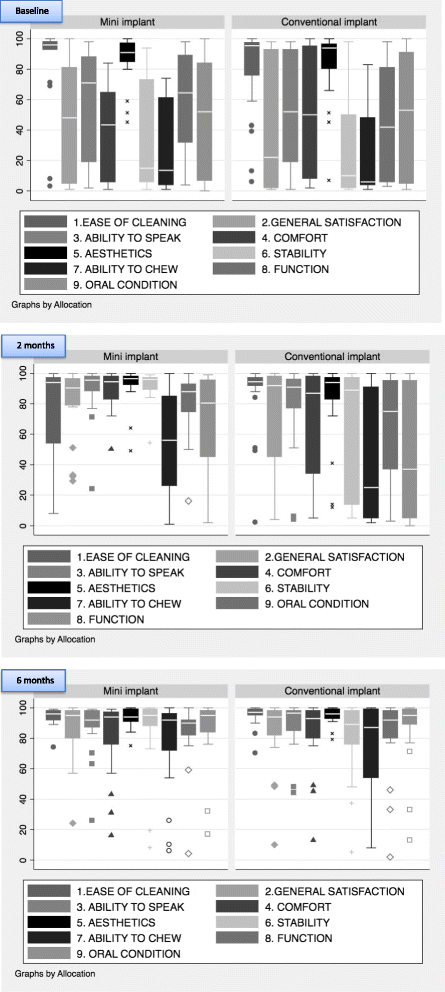
Similar articles
-
Retention of Mandibular Complete Overdentures using Mini Dental Implants (Ø < 3 mm) and Standard Diameter Implants (Ø > 3mm): A Systematic Review and Meta-Analysis of Randomised Controlled Trials.Oral Health Prev Dent. 2024 May 7;22:181-188. doi: 10.3290/j.ohpd.b5282167. Oral Health Prev Dent. 2024. PMID: 38713458 Free PMC article.
-
Comparison of three-implant-supported fixed dentures and two-implant-retained overdentures in the edentulous mandible: a pilot study of treatment efficacy and patient satisfaction.Int J Oral Maxillofac Implants. 2011 Mar-Apr;26(2):415-26. Int J Oral Maxillofac Implants. 2011. PMID: 21483895 Clinical Trial.
-
A 1-year prospective cohort study on mandibular overdentures retained by mini dental implants.Eur J Oral Implantol. 2012 Winter;5(4):367-79. Eur J Oral Implantol. 2012. PMID: 23304690
-
Mini-Implants for Mandibular Overdentures: Cost-Effectiveness Analysis alongside a Randomized Trial.JDR Clin Trans Res. 2018 Jan;3(1):47-56. doi: 10.1177/2380084417741446. Epub 2017 Nov 20. JDR Clin Trans Res. 2018. PMID: 30938654 Clinical Trial.
-
A systematic review of studies comparing conventional complete denture and implant retained overdenture.J Prosthodont Res. 2018 Jan;62(1):1-9. doi: 10.1016/j.jpor.2017.06.004. Epub 2017 Jun 27. J Prosthodont Res. 2018. PMID: 28666845
Cited by
-
Influence of marginal bone resorption on two mini implant-retained mandibular overdenture: An in vitro study.J Adv Prosthodont. 2021 Feb;13(1):55-64. doi: 10.4047/jap.2021.13.1.55. Epub 2021 Feb 23. J Adv Prosthodont. 2021. PMID: 33747395 Free PMC article.
-
Use of Narrow-Diameter Implants in Completely Edentulous Patients as a Prosthetic Option: A Systematic Review of the Literature.Biomed Res Int. 2021 Jun 22;2021:5571793. doi: 10.1155/2021/5571793. eCollection 2021. Biomed Res Int. 2021. PMID: 34239926 Free PMC article.
-
Retention of Mandibular Complete Overdentures using Mini Dental Implants (Ø < 3 mm) and Standard Diameter Implants (Ø > 3mm): A Systematic Review and Meta-Analysis of Randomised Controlled Trials.Oral Health Prev Dent. 2024 May 7;22:181-188. doi: 10.3290/j.ohpd.b5282167. Oral Health Prev Dent. 2024. PMID: 38713458 Free PMC article.
-
The Relationship Between Low Serum Vitamin D Level and Early Dental Implant Failure: A Systematic Review.Cureus. 2022 Jan 15;14(1):e21264. doi: 10.7759/cureus.21264. eCollection 2022 Jan. Cureus. 2022. PMID: 35178319 Free PMC article. Review.
-
The Effect of Mini Dental Implant Number on Mandibular Overdenture Retention and Attachment Wear.Biomed Res Int. 2023 Apr 30;2023:7099761. doi: 10.1155/2023/7099761. eCollection 2023. Biomed Res Int. 2023. PMID: 37168235 Free PMC article.
References
-
- Organization WH. International classification of functioning, disability and health: ICF: World Health Organization. 2001.
Publication types
MeSH terms
Substances
Grants and funding
LinkOut - more resources
Full Text Sources
Other Literature Sources

